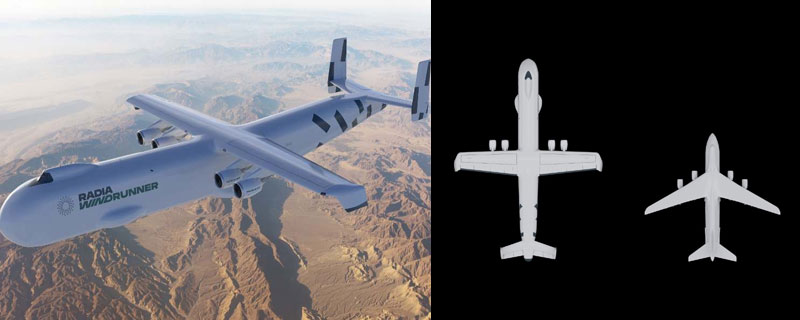Delivering mega onshore wind turbines
Size comparison between the WindRunner (L) and the record setting
Antonov AN-124 Ruslan heavy strategic military transport airplane (R). Image credit: Radia
US-based energy start-up Radia is planning to build the world’s largest aircraft, which the company claims will revolutionise the wind industry.
A June episode of the World Economic Forum’s Meet the Leader podcast highlighted the progress Radia is making in producing its WindRunner, a unique aerial transport solution designed to efficiently carry onshore wind turbines.
As turbines increase in size, Radia intends to aid in the transport of turbines, especially to remote areas. Radia claims that current road infrastructure can accommodate the transport of 70m turbines maximum, whereas the WindRunner cargo hold can carry a 100-metre-plus blade.
CEO and founder Mark Lundstrom explained in the podcast: “The world knows how to make offshore scale wind turbines. They’re just deployed in the ocean. And there’s this opportunity to bring gigantic turbines to onshore locations where the market is 10 or 20 times bigger…”
“This is the first time that an aircraft has been designed to optimize on volume instead of weight, and so it’s very unique in the sense that it can still move a lot of mass, 70 tons, but it has a volume that’s about 12 times bigger than a 747 aircraft,” Lundstrom added.
According to Lundstrom, the team intends to have a sizable fleet operating before 2029, with the “initial flights happening well before that”.
The aircraft will be manufactured and designed using off-the-shelf components that are already certified and mass-produced. This will lower the risk and speed up production.
The specs of the aircraft include:
- Length 108 m / 356 ft
- Height 24 m / 79 ft
- Wingspan 80 m / 261 ft
Radia’s plan is to manufacture the initial fleet and then set up operating bases around the world to serve different regions.
From those operating bases, WindRunner will be able to deliver to a 2,000km range.
A scenario described on the Radia website shows blade turbines being loaded into the aircraft at 4am and delivered to a remote destination by 11am the same day.









Leave a Reply
Want to join the discussion?Feel free to contribute!